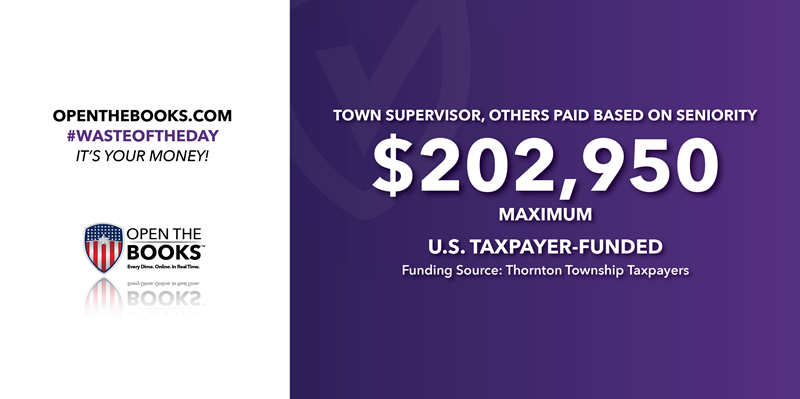
How Much Illinois Township Pays Elected Officials and Administrators Depends on Number of Terms
June 20, 2022

Thornton Township in Cook County, Illinois has come under fire for its wacky pay scale for local officials, paying them based on how many terms they’ve served. That makes for an uneven system where a first-term trustee makes $11,195 while doing the same job as an eighth-term trustee making $41,540.
The pay scale was recently uncovered by the Edgar County Watchdogs thanks to an open records request, which showed that in 2020, Thornton Township approved a new pay scale for its elected officials, with salaries based on seniority.
For their town supervisor, which ranges widely based on whether the board wants a part-time or full-time supervisor, the pay ranges from $48,400 and $202,950. For township assessors, their pay can be anywhere from $29,225 to $101,075. Township trustees can make between $11,195 and $41,540.
All positions take eight terms to max out compensation. The clerk and trustees each serve four-year terms, so politicians who stick around for 32 years get the highest pay.
Critics like the Edgar County Watchdogs argue that starting elected officials at such a low salary is meant to discourage outsiders from getting involved in government, while rewarding career politicians with continuous pay raises.
Politicians shouldn’t have a monetary incentive to stay in office forever.
A government official should be paid a modest but fair salary that is competitive and standardized, not one that changes based on how long they hold onto power.
U.S. Spends $50K to Encourage Palestinian Tourism
June 21, 2022

The Department of State’s U.S. Mission to Jerusalem will provide up to $50,000 to promote American tourism in Palestine, according to a recent grant notice.
The objectives of the grant include:
- “An enhanced and more diversified Palestinian tourism sector
- Improved capacities of tourism-related Palestinian businesses and entrepreneurs
- Support for at least one of the following types of tourism: eco; cultural life, food, heritage and tradition; adventure, sports, and recreation
- Availability of additional English-language resources for the Palestinian tourism sector
- Improved knowledge and understanding among Palestinian people of American tourists’ interests and demand”
The grant notice encourages proposals to include, “A series of events, academic and professional lectures, seminars, speaker sessions, roundtables, networking, and trainings, programs that increase participants’ knowledge of the behavior and contemporary demands of modern American and international tourists, and that support youth and women’s entrepreneurial initiatives in tourism sector-related businesses.”
The U.S. State Department website warns tourists traveling to the West Bank in Palestine to “exercise increased caution when traveling to the West Bank due to terrorism and civil unrest.” They warn tourists not to travel to Gaza, “due to terrorism, civil unrest, and armed conflict.”
The money is designated to go to a non-profit in Palestine, but a culture of corruption means that most of the money will most likely not benefit its intended recipients. Transparency International reports that 62 percent of people surveyed believe corruption has increased in Palestine in the last year, and 17 percent of public services users have paid bribes in the last year.
There are plenty of ways the U.S. could help Palestine, but trying to fund the almost nonexistent tourism industry is not an effective method. Funding better infrastructure, public safety programs, and education about safety in Palestine would all be more effective than a grant like this.
Army Virtual Reality Could Waste Up To $22B
June 22, 2022

The U.S. Army is testing new technology for troops that integrates virtual reality into combat goggles to give soldiers more information on the battlefield.
In testing the equipment, troops were surveyed on many aspects of the equipment. However, one omission was assessing how much the Army would actually use it, which according to a Department of Defense Office of Inspector General report, could waste $22 billion.
While much of the report is redacted due to national security concerns, what is clear is that the new VR equipment, named Integrated Visual Augmentation System, or IVAS, would be a major change for soldiers in combat.
As with any change, if it is too much at once, or if there is not enough training to accompany the transition, soldiers simply will not use it. Or, perhaps soldiers on the ground know more than the VR developers about how applicable this technology is in combat situations, who might overestimate its usefulness.
Either way, it is important to collect feedback from the soldiers who will be using it. While they did ask some questions about it, the report says that “program officials did not define clear measures of user acceptance levels to determine whether IVAS will meet user needs.”
It notes that user acceptance levels are critical in determining how well the system meets user needs and would predict real-world usage.
If the usefulness of the VR technology is overestimated, then many units will be ordered and left unused, leading to substantial waste.
This is a rare case where waste is identified before the transaction occurs. Hopefully, the DOD will heed these recommendations and save taxpayers almost $22 billion.
Throwback Thursday: General Services Administration Lost Tickets Worth $7M
June 23, 2022

Throwback Thursday!
In 1982, the U.S. General Services Administration, the agency that administratively supports other executive agencies, lost $7 million — about $21 million in 2022 dollars — worth of forms used to buy airline tickets.
Sen. William Proxmire, a Democrat from Wisconsin, awarded the GSA his Golden Fleece Award for the agency’s utter disregard for taxpayers money.
These forms, about 49,000 of them, functioned like open-ended airline ticket vouchers, with the GSA stating that these forms “should be considered and are as good as cash” for buying flights for official government business.
The forms were ordered in 1979. A misreading or misunderstanding of how the forms were sent led to the regional office ordering 50,000 forms instead of 500 forms.
When the agency attempted to return the extra 49,000 forms to the D.C. headquarters, the D.C. office had no way to process a return and refund, and advised the regional office to destroy all extra forms.
Instead of wasting $7 million by destroying them, the region stored them in an unlocked storage room while they continued trying to sort the situation out. As time passed and employees came and went, the forms were forgotten about, until an audit rolled around. When officials tried to find them, they were gone.
First, they said the forms were sent to another regional office, but that office denied ever receiving them. Then, they claimed the forms may have simply been thrown away.
Whatever happened to those forms, a silly bureaucratic bungle left taxpayers with a $7 million bill for forms that were never recovered.
Duplicative Federal Merit Board Gets $55M Annually
June 24, 2022

The Senate recently voted to confirm new members of the Merit Systems Protection Board, an agency that could easily be consolidated within a myriad of other federal bureaucracies, but nonetheless receives about $55 million in funding each year, according to spending records compiled by OpenTheBooks.com.
According its website, the Merit Board is, “an independent, quasi-judicial agency in the Executive branch that serves as the guardian of Federal merit systems.”
Its job is to perform duties related to “employee appeals,” as well as, “perform merit systems studies and to review the significant actions of Office of Personnel Management.” It also helps inform federal employees of their rights through educational resources.
It was created in 1978 along with the Office of Personnel Management and the Federal Labor Relations Authority. All three agencies used to be consolidated under the Civil Service Commission, but now are three separate entities.
The board’s page lists more of what it doesn’t do than what it does. It has a list of six common issues that are covered by other agencies. It seems all the merit board does is hear appeals from federal employees on specific matters, and conduct oversight on the Office of Personnel Management.
Both of those duties could easily and more efficiently be performed by existing agencies like the Office of Personnel Management and the Federal Labor Relations Board.
Originally, the merit board was also supposed to include an office of special counsel to “investigate allegations of prohibited personnel practices, prosecute violators of civil service rules and regulations, and enforce the Hatch Act.” While this important job may have made the board an important standalone agency, with its departure, it could be consolidated.
The #WasteOfTheDay is presented by the forensic auditors at OpenTheBooks.com.